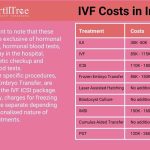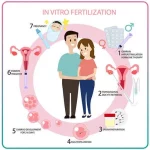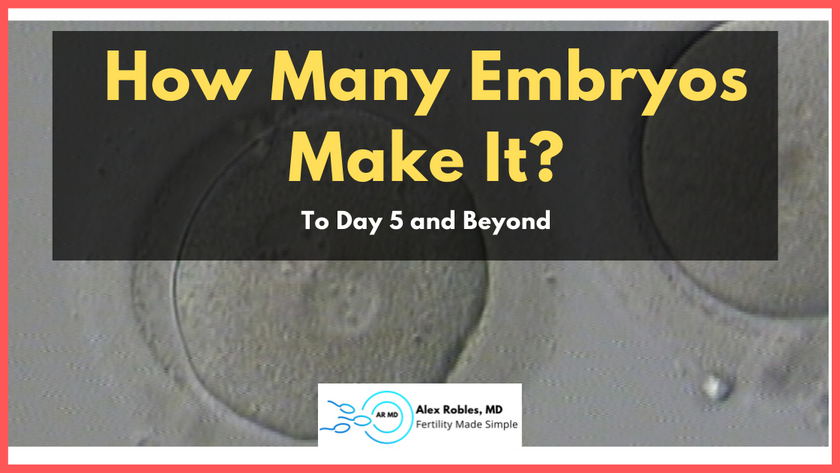
How Much Is IVF in Illinois? Your Guide to Costs, Coverage, and Options
April 19, 2025
Does IVF Work? Your Guide to Understanding In Vitro Fertilization Success
April 19, 2025How Many Eggs Are Fertilized in IVF?

How Many Eggs Are Fertilized in IVF?
In vitro fertilization (IVF) is a life-changing journey for many hoping to build a family. If you’re exploring this option, one question might be swirling in your mind: how many eggs actually get fertilized during the process? It’s a big piece of the puzzle, and understanding it can help you feel more prepared for what lies ahead. Let’s dive into the world of IVF, break down the numbers, and uncover what really happens behind the scenes—plus a few surprises that don’t always make it into the usual conversations.
The IVF Basics: A Quick Rundown
IVF is like a carefully choreographed dance between science and hope. It starts with boosting your ovaries to produce multiple eggs, retrieving those eggs, fertilizing them with sperm in a lab, and then transferring the resulting embryos into the uterus. But here’s the catch—not every egg retrieved makes it to the finish line. The number of eggs fertilized depends on a mix of factors, from your age to the quality of the sperm and even the techniques used in the lab.
On average, about 70% of mature eggs retrieved during IVF will successfully fertilize. So, if 10 eggs are collected, you might see around 7 turn into embryos. But that’s just the starting point. Let’s peel back the layers and see what influences those numbers—and what you can expect along the way.
What Happens to Eggs in IVF?
The journey of an egg in IVF is a bit like a talent show: not every contestant moves on to the next round. Here’s a step-by-step look at what happens:
Step 1: Egg Retrieval
First, fertility drugs stimulate your ovaries to produce multiple eggs—way more than the one egg your body naturally releases each month. Doctors aim for 8-15 eggs in a single cycle, though this varies. Once the eggs are mature, they’re collected in a quick procedure using a tiny needle guided by ultrasound.
Step 2: Checking Maturity
Not all retrieved eggs are ready to shine. Some are immature and can’t be fertilized yet. Typically, 80-90% of retrieved eggs are mature, meaning they’re at the right stage to meet sperm. For example, if 12 eggs are retrieved, about 10 might be mature.
Step 3: Fertilization Time
In the lab, mature eggs meet sperm. There are two main ways this happens:
- Traditional IVF: Eggs and sperm are mixed together in a dish, letting nature take its course.
- ICSI (Intracytoplasmic Sperm Injection): A single sperm is injected directly into each egg, often used when sperm quality is low.
On average, 70% of mature eggs fertilize successfully. So, from those 10 mature eggs, about 7 might become embryos. But this isn’t a guarantee—sometimes it’s more, sometimes less.
Step 4: Embryo Development
Fertilized eggs (now embryos) grow in an incubator for 3-5 days. By day 5, the strongest ones reach the blastocyst stage, ready for transfer or freezing. Only about 30-50% of fertilized eggs make it this far, depending on quality and other factors.
Here’s a quick snapshot of the numbers:
| Stage | Example Numbers (Starting with 12 Eggs) |
|---|---|
| Eggs Retrieved | 12 |
| Mature Eggs | 10 (80-90%) |
| Fertilized Eggs | 7 (70% of mature eggs) |
| Blastocysts (Day 5) | 3-5 (30-50% of fertilized eggs) |
These are averages—your results could look different, and that’s totally normal.
Why Don’t All Eggs Fertilize?
You might wonder why some eggs don’t make the cut. It’s not a flaw in the process; it’s just biology doing its thing. Here are a few reasons:
- Egg Quality: As we age, egg quality dips. For women under 35, more eggs are likely to fertilize compared to women over 40.
- Sperm Quality: If sperm struggles to penetrate the egg (or isn’t motile enough), fertilization rates drop. ICSI can help here.
- Lab Conditions: Even with top-notch labs, tiny variations in temperature or timing can affect success.
- Natural Attrition: In a natural cycle, not every egg would fertilize either—it’s a built-in filter of human reproduction.
Think of it like baking cookies: you might start with a big batch of dough, but not every cookie comes out perfect. IVF just gives you more dough to work with.
How Many Eggs Should You Aim For?
There’s no magic number of eggs that guarantees success, but doctors often target 8-15 per cycle. Why? It’s a sweet spot—enough to boost your chances of getting viable embryos, but not so many that you risk complications like ovarian hyperstimulation syndrome (OHSS).
Here’s what the research says:
- Women with 10-15 eggs retrieved have a 65% chance of a healthy embryo leading to pregnancy.
- Fewer than 5 eggs? The odds drop, but success is still possible.
- Over 20 eggs? You might get more embryos, but quality can sometimes take a hit, especially if conditions like PCOS are involved.
So, how many fertilized eggs do you need? Ideally, 3-5 good embryos give you a solid shot at pregnancy—either now or later with frozen transfers. For two kids, some experts suggest aiming for 20-24 mature eggs across cycles, assuming about half become viable embryos.
Interactive Quiz: What’s Your IVF Number?
Curious about your own IVF journey? Take this quick quiz to get a rough idea (no medical advice here—just fun!):
- How old are you?
- A) Under 35
- B) 35-37
- C) 38-40
- D) Over 40
- How many eggs do you think you’d produce in a cycle? (Ask your doctor for an estimate!)
- A) 5 or fewer
- B) 6-10
- C) 11-15
- D) 16+
- Any known fertility challenges?
- A) Nope, all clear
- B) Maybe sperm issues
- C) Possible egg quality concerns
- D) A mix of factors
Results:
- Mostly A’s: You might see 70-80% fertilization—great odds!
- Mostly B’s: Around 60-70% could fertilize—solid numbers.
- Mostly C’s or D’s: Expect 50-60%, but techniques like ICSI can boost your chances.
Chat with your doctor to refine this—it’s just a starting point!
The Age Factor: How It Shapes Fertilization
Age is the biggest player in the IVF game. Younger eggs are more likely to fertilize and grow into healthy embryos. Here’s a breakdown based on 2022 data from the CDC:
- Under 35: 55% success rate per cycle; 70-80% of mature eggs fertilize.
- 35-37: 40% success rate; 60-70% fertilize.
- 38-40: 26% success rate; 50-60% fertilize.
- Over 40: 10-15% success rate; 40-50% fertilize (often with donor eggs boosting odds).
Why the drop? Older eggs have more chromosomal hiccups, making fertilization trickier. If you’re over 40, don’t lose hope—donor eggs or extra cycles can shift the odds in your favor.
Fresh vs. Frozen: Does It Change Fertilization?
Here’s something you might not hear often: whether you use fresh or frozen embryos doesn’t directly affect how many eggs fertilize. Fertilization happens before freezing. But freezing does impact what comes next:
- Fresh Transfers: Embryos go straight to the uterus after 3-5 days. About 70% of mature eggs fertilize, and 30-50% reach blastocyst.
- Frozen Transfers: Extra embryos are frozen, thawed later, and transferred. Freezing tech is so good now (thanks to vitrification) that survival rates are 95%+, and pregnancy rates match fresh cycles.
Fun fact: A 2023 study in Fertility and Sterility found frozen embryo transfers might even edge out fresh ones for women over 38, thanks to better uterine prep. So, fertilizing more eggs upfront can stockpile options for later.
Boosting Your Fertilization Rates: Tips That Work
Want to tilt the odds in your favor? While you can’t control everything, small tweaks can make a difference. Here’s what the latest trends and research suggest:
✔️ Eat Smart: A Mediterranean diet (think fish, nuts, and veggies) is linked to better egg quality. A 2024 study in Human Reproduction showed women on this diet had 15% higher fertilization rates.
✔️ Sleep Well: Aim for 7-8 hours. Poor sleep messes with hormones, dropping fertilization by up to 10%, per a 2023 sleep study.
✔️ Cut Stress: High cortisol can lower egg quality. Yoga or mindfulness might bump your success by 5-10%, according to recent X platform chatter from IVF vets.
❌ Skip the Junk: Too much sugar or processed food? Studies tie it to lower fertilization rates.
❌ Don’t Overdo Caffeine: More than 200 mg daily (about two coffees) might reduce success by 7%, per a 2022 review.
DIY Fertility Boost Checklist
Try this for a month before your cycle:
- Eat salmon or walnuts 3x a week.
- Set a bedtime alarm for consistency.
- Take 10 minutes daily to breathe deeply or stretch.
Tiny steps, big potential payoff.
The Emotional Side: Coping with the Numbers
IVF isn’t just about stats—it’s personal. Seeing 12 eggs drop to 3 embryos can feel like a rollercoaster. Here’s what real people on X say:
- “Started with 15 eggs, got 5 fertilized. It stung, but 1 stuck—I’m 6 months pregnant now!”
- “Only 2 out of 8 fertilized. Felt like a failure until my doc said it’s normal.”
The truth? Attrition is part of the process. Celebrate the ones that make it—they’re your champs.
Poll: How Do You Feel About Your Numbers?
Vote below and see what others think:
- A) “I’m thrilled with any fertilized eggs!”
- B) “It’s stressful when the numbers drop.”
- C) “I just want one healthy embryo—don’t care how many start.”
Check back next week for results!
New Frontiers: What’s Changing IVF Fertilization?
IVF isn’t standing still. Here are three game-changers not getting enough airtime:
1. Microfluidics: Precision Fertilization
Labs are testing “IVF-on-a-chip” tech. Tiny channels sort the best sperm, boosting fertilization rates by up to 20%, per a 2024 Nature study. It’s like giving sperm a VIP pass to the egg.
2. Stem Cell Eggs
For women with low egg counts, scientists are growing eggs from stem cells. Early trials (2023) show promise—think 5-10 extra eggs per cycle. It’s not mainstream yet, but it could rewrite the rules.
3. AI-Powered Embryo Selection
Artificial intelligence now predicts which fertilized eggs will thrive. A 2024 trial cut attrition by 15%, meaning more embryos reach blastocyst. Your clinic might already use this—ask!
These breakthroughs mean higher fertilization rates and better odds down the road. Exciting, right?
Real Stories: Fertilization in Action
Meet Sarah, 34, from Texas. She retrieved 14 eggs in her first cycle. Eleven were mature, and 8 fertilized. By day 5, 4 became blastocysts. One transfer later, she’s expecting twins. “I obsessed over the numbers,” she says, “but it only takes one—or two!”
Then there’s Mark and Jen, both 39. They got 9 eggs, 6 fertilized, and 2 made it to blastocyst. After a failed fresh transfer, a frozen one worked. “Those two fighters were enough,” Jen laughs.
Your story might look different, but every fertilized egg is a step closer.
FAQs: Your Burning Questions Answered
Q: Can I get more eggs fertilized in a second cycle?
A: Maybe! Adjusting meds or timing can help. One study found a 10% bump in fertilization rates on cycle two with tweaks.
Q: What if none fertilize?
A: It’s rare (5% of cycles), but it happens. Doctors might suggest donor eggs/sperm or a different approach next time.
Q: Does freezing eggs affect fertilization later?
A: Nope—frozen eggs fertilize just as well as fresh ones, with 70% success rates post-thaw, per 2023 data.
Wrapping Up: Your IVF Journey
So, how many eggs get fertilized in IVF? On average, 70% of mature eggs cross that line—say, 7 out of 10. But it’s not just about quantity; it’s about quality, timing, and a sprinkle of luck. Whether you’re starting with 5 eggs or 20, each one’s a tiny spark of possibility.
Stay curious—talk to your doctor, track your cycle, and lean into the process. IVF’s a marathon, not a sprint, and every fertilized egg brings you closer to the finish line. What’s your next step? Drop a comment or share your story—I’d love to hear it!

